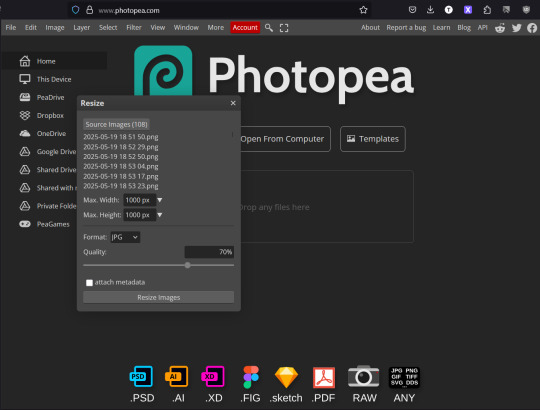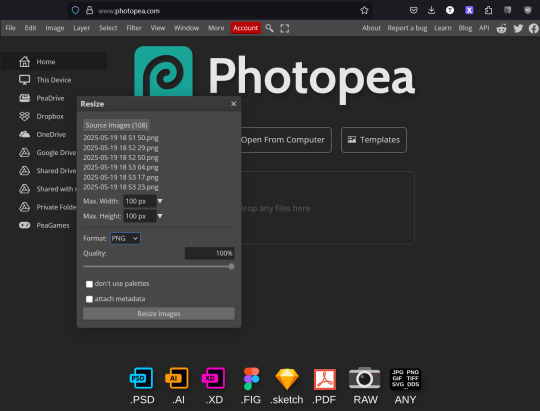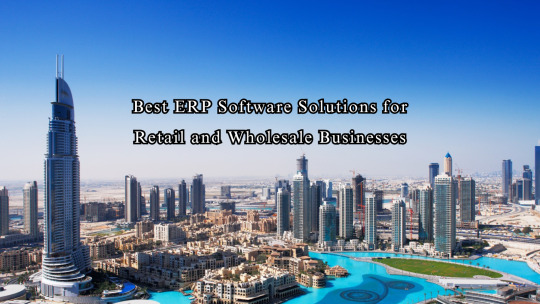#purchase order software open source
Explore tagged Tumblr posts
Text
Photopea: How to batch resize square icons (101)

I personally use photoshop for most of my graphics need, but I know that this is not an option for a lot of folks, and I've decided to make a couple of RP specific tutorials using Photopea (free, web based, no software to install) and Krita (free, install required).
This first post is for Photopea.
You can grab your screenshots of comic books (for instance) with picpick or another software that allows you to screengrab specific shapes / pixel sizes. I use picpick (I purchased pro for my use, but if you don't intend to do sell your icons you may use the free version. It is as complete as the paying version) to screen grab at 150x150px. Tutorial from RPCheapos here. (For live action/animated, I recommend using "free video to jpg converter" for better results)
Now on to the resizing (Very Easy To Do imo) with a bunch of screen shots to show you the steps.
First step is to open www.photopea.com. You can create an account if you'd like. As it is a free site that lives thanks to ads, I would recommend turning off adblocker for this specific site.
Click File > Automate > resize image:

It will open a little pop up called "Resize". Click on Source Images. They're your screen grabs that you want to resize to a smaller size:

Caveat: I never tried more than a hundred screenshots at once. So do with that what you will. I've read posts of folks who have issues if they put too many pictures into photopea at once, but I never experienced that type of issues.
Once your images are loaded:

Change the parameters to your desired width/height. Note: it does NOT crop. If your screen grabs aren't square now, they won't be square after! Also select your favored format (I favor PNG over JPG: higher quality & supports transparency if needed)

After you click resize, it will open a popup in order to save your newly resized icons into a zip folder. Save it wherever you'd like with a name that talks to you, unzip the file, and now you have your resized icons!

This is pretty powerful but also! pretty limited. No cropping, no coloring, no sharpening, etc. But it is a good jumping point imo when you get started and just want all your icons to be the same size.
Take care, and sprinkle sparkles in your life!
~Emma
9 notes
·
View notes
Text
I bought an 8bitdo Retro mechanical keyboard!

(Picture not mine, source from PC World.)
I wanted a plastic keyboard, I really do not actually use the knob on a Keychron board I have, it still comes in a scooped keycap profile, and it has a companion numpad with a calculator built in. Win/win/win!
This keyboard comes in four designs (not colorways, full designs) themed after the NES, the Famicom, the IBM Model M, and the Commodore 64 keyboard. The NES keycaps have multiple different fonts on them, the Famicom keycaps have Japanese sublegends, the Model M keycaps have a mock stepped Caps Lock key, and the Commodore 64 keycaps are an apparently off-the-shelf SA set from one of many, many, many keycap companies floating around China (I recognize their font and profile shape from Akko ASA keycaps and numerous other scooped profile keycap sets you can have cheaply off of Aliexpress and Amazon. Do check those out, genuinely, you'd struggle to find a bad scooped keycap set these days and I love scooped profiles over Cherry and OEM.)
The build quality of the actual keyboard itself is good, feels like a very similar plastic blend to what 8bitdo uses for its controllers like their Pro 2. Stabilizers are smooth and don't rattle, the legends on the keycaps are reasonably sharp and in NES-appropriate font, the keycaps themselves are MDA profile (I would prefer SA, but beggars can't be choosers) and are somewhat thin but still good quality, dye-sublimated PBT, no warp on the spacebar. Arrow keys are a separate color from the two tones that make up the main keycap set and made to resemble a d-pad. The keyboard itself is somewhat light, but my perception is skewed from using a metal keyboard for a long time, and this is after all a plastic shell, top-mounted keyboard. Even so I think I'll probably end up cracking open the keyboard and putting in some liquid silicone as noise-dampening and additional weight.
Two knobs control both wireless functionality and computer software volume, the wireless knob is heavy with only three options while the volume one is light with many individual steps. The volume knob can be somewhat unresponsive on individual steps. Bluetooth is very responsive and wants to pair with my computer the moment it's flicked over to, and 2.4ghz wireless comes with a receiver that slots into the back of the keyboard magnetically for storage. A power light on the right of the keyboard mimics the NES power light and pulses while charging, is steady while using wireless or when fully charged and connected over USB.
The underlying PCB is south-facing hotswap sockets (who the hell cares their orientation, this only matters for lighting, which this keyboard doesn't have). By default the keyboard comes with Kailh box whites, a very light clicky switch. I yanked them out immediately and put Boba U4T tactiles in because they're the king of all switches. They thunk nicely in this chassis, the Kailh whites weren't slouches either, they did pick a good stock choice for switch without resorting to Gateron or Outemu blue horseshit.
The NES version of the keyboard came with a two-button macro pad that hooks over TRRS cable (you recognize it as a 3.5mm jack or headphone cable) to one of four ports on the top-right of the keyboard. These are essentially just two keyboard switches with giant keycaps on a separate board and the buttons are populated by Gateron greens. The switches are nowhere close to heavy enough to approximate a button, and I gave them Kailh box navies. Still not enough, but better.
These keyboards also come wiiiiiith a companion number pad!

(Picture credit the 8bitdo store.)
While I don't actually have this one in hand just yet I do have it on order. It looks like it'll be about the same build quality as the main keyboard, and it caught my eye for four reasons and ended up making me purchase the full set as a result:
The numpad has a built in calculator.
Same aesthetic choices as the main keyboard (NES, Famicom, IBM Model M, Commodore 64)
Magnetically attaches to the right side of the keyboard to transform it into a more era appropriate full-size.
Far and away the cheapest wireless mechanical numpad with calculator on the market, sitting at $45.
An important note though is that the Famicom and NES keypads don't attach to their respective keyboards, simply because their respective keyboards don't have magnets inside the sides of the chassis to allow for it. I have some cheap button magnets laying around that I'll use for this purpose and probably see if they're strong enough to be placed on the inside of the board and allow for the numpad to connect to it. I also imagine there's going to be a repop or v2 of this keyboard in the future that has this done already, seeing as the Commodore 64 version of the board and I believe the Model M version of the board already have that.
I'll reblog this and give some actual definitive thoughts on the numpad once it's in my hands.
As far as the board itself is concerned, I quite like it. The keycap profile is agreeable, the nostalgia pandering targeted me with laser precision, the board sounds quite good acoustically (especially for being a top-mount keyboard!) and it has a volume knob I'll see if I can reprogram some day. While I normally hate TKL layouts, I'm putting up with it because it will eventually be a fullsize with the numpad. Worth $150 total? Don't know, can't answer that for you, it's worth it to me but I very specifically wanted a keyboard themed after an old Nintendo console with no setup required and no chasing down or commissioning GMK keycap sets. I also wanted a calculator numpad.
#look at my flop reviews boy#mechanical keyboards#keyboards#mechanical keyboard#keyboard#tech#gadgets#computers#nintendo#NES#nintendo entertainment system
47 notes
·
View notes
Text
Last year, the White House struck a landmark safety deal with AI developers that saw companies including Google and OpenAI promise to consider what could go wrong when they create software like that behind ChatGPT. Now a former domestic policy adviser to President Biden who helped forge that deal says that AI developers need to step up on another front: protecting their secret formulas from China.
“Because they are behind, they are going to want to take advantage of what we have,” said Susan Rice regarding China. She left the White House last year and spoke on Wednesday during a panel about AI and geopolitics at an event hosted by Stanford University’s Institute for Human-Centered AI. “Whether it’s through purchasing and modifying our best open source models, or stealing our best secrets. We really do need to look at this whole spectrum of how do we stay ahead, and I worry that on the security side, we are lagging.”
The concerns raised by Rice, who was formerly President Obama's national security adviser, are not hypothetical. In March the US Justice Department announced charges against a former Google software engineer for allegedly stealing trade secrets related to the company’s TPU AI chips and planning to use them in China.
Legal experts at the time warned it could be just one of many examples of China trying to unfairly compete in what’s been termed an AI arms race. Government officials and security researchers fear advanced AI systems could be abused to generate deepfakes for convincing disinformation campaigns, or even recipes for potent bioweapons.
There isn’t universal agreement among AI developers and researchers that their code and other components need protecting. Some don’t view today’s models as sophisticated enough to need locking down, and companies like Meta that are developing open source AI models release much of what government officials, such as Rice, would suggest holding tight. Rice acknowledged that stricter security measures could end up setting US companies back by cutting the pool of people working to improve their AI systems.
Interest in—and concern about—securing AI models appears to be picking up. Just last week, the US think tank RAND published a report identifying 38 ways secrets could leak out from AI projects, including bribes, break-ins, and exploitation of technical backdoors.
RAND’s recommendations included that companies should encourage staff to report suspicious behavior by colleagues and allow only a few employees access to the most sensitive material. Its focus was on securing so-called model weights, the values inside an artificial neural network that get tuned during training to imbue it with useful functionality, such as ChatGPT’s ability to respond to questions.
Under a sweeping executive order on AI signed by President Biden last October, the US National Telecommunications and Information Administration is expected to release a similar report this year analyzing the benefits and downsides to keeping weights under wraps. The order already requires companies that are developing advanced AI models to report to the US Commerce Department on the “physical and cybersecurity measures taken to protect those model weights.” And the US is considering export controls to restrict AI sales to China, Reuters reported last month.
Google, in public comments to the NTIA ahead of its report, said it expects “to see increased attempts to disrupt, degrade, deceive, and steal” models. But it added that its secrets are guarded by a “security, safety, and reliability organization consisting of engineers and researchers with world-class expertise” and that it was working on “a framework” that would involve an expert committee to help govern access to models and their weights.
Like Google, OpenAI said in comments to the NTIA that there was a need for both open and closed models, depending on the circumstances. OpenAI, which develops models such as GPT-4 and the services and apps that build on them, like ChatGPT, last week formed its own security committee on its board and this week published details on its blog about the security of the technology it uses to train models. The blog post expressed hope that the transparency would inspire other labs to adopt protective measures. It didn’t specify from whom the secrets needed protecting.
Speaking alongside Rice at Stanford, RAND CEO Jason Matheny echoed her concerns about security gaps. By using export controls to limit China’s access to powerful computer chips, the US has hampered Chinese developers’ ability to develop their own models, Matheny said. He claimed that has increased their need to steal AI software outright. By Matheny’s estimate, spending a few million dollars on a cyberattack that steals AI model weights, which might cost an American company hundreds of billions of dollars to create, is well worth it for China. “It’s really hard, and it’s really important, and we’re not investing enough nationally to get that right,” Matheny said.
China’s embassy in Washington, DC, did not immediately respond to WIRED’s request for comment on theft accusations, but in the past has described such claims as baseless smears by Western officials.
Google has said that it tipped off law enforcement about the incident that became the US case alleging theft of AI chip secrets for China. While the company has described maintaining strict safeguards to prevent the theft of its proprietary data, court papers show it took considerable time for Google to catch the defendant, Linwei Ding, a Chinese national who has pleaded not guilty to the federal charges.
The engineer, who also goes by Leon, was hired in 2019 to work on software for Google’s supercomputing data centers, according to prosecutors. Over about a year starting in 2022, he allegedly copied more than 500 files with confidential information over to his personal Google account. The scheme worked in part, court papers say, by the employee pasting information into Apple’s Notes app on his company laptop, converting the files to PDFs, and uploading them elsewhere, all the while evading Google’s technology meant to catch that sort of exfiltration.
While engaged in the alleged stealing, the US claims the employee was in touch with the CEO of an AI startup in China and had moved to start his own Chinese AI company. If convicted, he faces up to 10 years in prison.
5 notes
·
View notes
Text
Nippon Ichi Software announces roguelike strategy RPG Bar Stella Abyss for PS5, PS4, and Switch
Gematsu Source
[I hit the 30 image limit, so some near the bottom are missing, but you can check the site for them]

Nippon Ichi Software has announced roguelike strategy RPG Bar Stella Abyss for PlayStation 5, PlayStation 4, and Switch. It will launch on February 29, 2024 in Japan.
Here is the announcement trailer:
youtube
Get the first details below.
■ Specifications
Title: Bar Stella Abyss
Genre: Roguelike strategy RPG
Platforms: PlayStation 5, PlayStation 4, Switch
Release Date: February 29, 2024 (Japan)
Players: One
Price: 7,200 yen (without tax) / 7,920 yen (with tax)
Publisher: Nippon Ichi Software
Development Manager: Shunsuke Minowa
Planning and Concept / Art Director: Yu Mizokami
Character Design: Mio Katsumata
CERO Rating: Pending
Official Website: nippon1.jp
Official Hashtag: #BARステラアビス

■ Game Overview
Bar Stella Abyss is a roguelike strategy RPG in which you strengthen your party with the power of the constellations while exploring a dungeon in another world that changes form each time you play. In addition to exploring the other world, the story will unravel as you share drinks with the peculiar patrons of the bar “Stella Abyss.”




■ Story

Stella Abyss is a hidden bar tucked away in the corner of the city. The protagonist, tired out by their day to day, is guided there by a flyer floating in the wind and opens its doors. “You seem to be extremely exhausted. Allow me to make you something right away.” Drunk on the cocktail he ordered as recommended by the bartender, the protagonist fell asleep. The hungover protagonist woke up to an unfamiliar voice echoing in their head. Before them was a mysterious creature floating in the air, and a magical scene of flowers in bloom. This is the “Drunken World,” the dream of a drunk person. The protagonist was robbed of their face and arm, and left trapped in this dream world.
■ Characters
Wanderer (voiced by Nanako Mori) A wanderer who lost their face and arm.

The protagonist, who arrives at the hidden bar Stella Abyss after following a flyer floating in the wind through the city at night. In order to get back the face and arm they lost in the Drunken World, they must go back and forth between the bar and other world.

Master (voiced by Ayaka Shimizu) Owner of the hidden bar Stella Abyss.
“Welcome to the bar Stella Abyss.”

A gentle-mannered woman adored by her regulars. She also seems to know about the Drunken World. She offers all sorts of advice to the protagonist, who is taken aback by the sudden events.

Tipsy (voiced by Michiyo Murase) A servant of the Drunken World’s god.
“Humans really are stupid to drink so much more than they can handle.”

A creature who saves the protagonist after wandering into the Drunken World and names them “Wanderer.” They do whatever they can to help catch the thief who stole the protagonist’s face and arm.

■ System
Explore the Drunken World You Reach After Drinking Yourself Unconscious
The Drunken World is said to exist in countless numbers like stars. The protagonist Wanderer travels around this profoundly mysterious world to get back their lost face and arm.

—Dungeons are scattered with facilities that will aid in your exploration, including an observatory where you can obtain enhanced skills, and shops where you can purchase items. It is up to the player to decide which facilities to progress through.


—If you encounter any of Stella Abyss’ regulars in the Drunken World, you can add them to your party. With their help, aim to reach the depths of the Drunken World.

—When you use up all your strength in the Drunken World, you will wake up in the bathroom of Stella Abyss. Equipment aside, all items will be lost and your level will return to its initial state.

Turn-Based Strategy RPG Battles
When you encounter the monsters that roam about the Drunken World, the fight will shift to a tile-based battle map. Combat progresses like a turn-based strategy RPG. Choose your actions while paying attention to the enemy’s weaknesses and placement, as well as terrain effects.


Strengthen Characters with the Power of Constellations
As you explore, you will obtain “Stella,” which are the powers of the constellations. By setting a Stella to a character’s skill, its performance can be enhanced in ways such as expanded attack range, additional power, or granting additional attributes.


There are around 130 different Stella that will randomly appear, and up to four can be equipped for a single skill, but all Stella will reset once your run ends. Try out different combinations of Stella for every run.


For example, by combining the Stella “Double Backstep,” which allows you to move back two tiles, and “High-Speed Firing,” which increases your power the further away you are from an enemy, you can create a skill that deals high damage while also keeping a safe distance from the enemy.
Smooth Conversation and Exploration Through the Power of Alcohol

By sharing drinks with the other regulars, you can gain effects that will aid you on your journey in the Drunken World. —Stella Abyss has several regulars that come in for a drink. Talk to those that pique your interests and share a table.


The Patrons of Stella Abyss
The men and women of Stella Abyss. They will also appear in the Drunken World, where only those who “lost something important” are said to reach, and help out the protagonist.

From left to right, the regular patrons include:
Kaji (voiced by Hiroshi Watanabe)
Baran (voiced by Hiromu Mineta)
Kiruca (voiced by Mikoi Sasaki)
Cass (voiced by Momoyo Koyama)
Leona (voiced by Honoka Kuroki)
Maia (voiced by Riho Sugiyama)
Jinga (voiced by Mutsuki Iwanaka)
Saotome (voiced by Takaki Otomari)
Enjoy Conversation with the Regulars
By sharing a table with the regulars at Stella Abyss, you can enjoy conversation. There are four prompts you can choose from as reactions during a conversation, including “Agree,” “Disagree,” “Laugh,” and “Doubt,” as well as the additional option of “Drink” for a total of five options. Choose the most appropriate reaction to match the other person’s feelings and drive the conversation forward. —If you make a comment that disrupts the flow of the conversation or offends the other person, the conversation will not flourish and your time drinking together will end.

—If you choose “Drink” too much, your vision will blur and you will be forced into the Drunken World. Be sure to pace yourself when drinking…
The Hidden Effects of Cocktails
The cocktails of Stella Abyss will bestow special effects that will aid you in the Drunken World. There are various effects, from granting additional experience points to increasing the appearance rate of certain Stella. Order cocktails that match your exploration style. —If your conversation flourishes while sharing a table, you can order additional cocktails. Two drinks, three drinks… the effects will accumulate the more you drink, allowing you to explore the dungeon with an advantage. —There are over 300 cocktails. By spending the money you collect in the Drunken World, you can unlock cocktails with more powerful effects.
■ Box Art
■ First-Print Bonus
First-print copies of the physical edition will include a download code for the digital mini soundtrack, which contains eight tracks carefully selected from the game’s background music.
■ Nippon1.jp Shop Limited Edition

The Nippon1.jp Shop Limited Edition includes:
A copy of the game
Soundtrack CD – Three discs. Includes every background music track from the game.
Visual art book – 44 pages, B6-size. Includes artwork from the game.
Special Box – Can be used to store the soundtrack CD and visual art book.
Acrylic art board – A5 size.
Pre-orders are available here: PlayStation 5, PlayStation 4, and Switch.
View the screenshots at the gallery.
#Bar Stella Abyss#Nippon Ichi Software#Nippon Ichi#Roguelike#SRPG#RPG#Gematsu#Hoping for a localization announcement#Youtube
12 notes
·
View notes
Text
On August 12, 2019, Verizon Media announced that it would sell Tumblr to Automattic, the operator of blog service WordPress.com and corporate backer of the open source blog software of the same name. The sale was for an undisclosed amount, but Axios reported that the sale price was less than $3 million, less than 0.3% of Yahoo's original purchase price. Automattic CEO Matt Mullenweg stated that the site will operate as a complementary service to WordPress.com, and that there were no plans to reverse the content policy decisions made during Verizon ownership.[2]
In November 2022, Mullenweg stated that Tumblr will add support for the decentralized social networking protocol ActivityPub.[25] In November 2023, most of Tumblr's product development and marketing teams were transferred to other groups within Automattic. Mullenweg stated that focus would shift to core functionality and streamlining existing features.[26]
In February 2024, Automattic announced that it would begin selling user data from Tumblr and WordPress.com to Midjourney and OpenAI. Tumblr users are opted-in by default, with an option to opt out.[27][28]
In August 2024, Automattic announced that it would migrate Tumblr's backend to an architecture derived from WordPress, in order to ease development and code sharing between the platforms. The company stated that this migration would not impact the service's user experience and content, and that users "won't even notice a difference from the outside".[29]
2 notes
·
View notes
Text
Could We Peer Produce Movies?
A thought experiment on modern modes of production
originally published 8-28-2023 on my blog
Introduction
In the world of the modern internet, there exists a concept called peer production. You’re probably already very familiar with works produced under this mode. Wikipedia primarily bases its content off of peer production. Likewise almost all free and open source software like the Linux servers that run 90% of the internet, are also made using peer production models.
Last year though, something very interesting happened. A meme went viral on Tumblr about a fake Martin Scorse film called Goncharov. A collective running bit, the meme attracted songs, spec scripts, movie posters, costume designs, and so many other artifacts that would be assembled as part of a pre-production or a pitch process for a movie. All of which were created and distributed through a type of decentralized, uncoordinated peer production. It made me wonder what could have been produced if there had been some tool, structure, or platform to focus all that energy into an actual production.
Especially, in the light of the ongoing SAG-AFTRA & WGA strikes, I think there’s an interesting moment for change in the way entertainment is produced in the USA. The workers that make movies & TV in the country are on strike right now because the middleman bureaucracy of studio production has squeezed too hard & has reached the point that it is trying to push all the humans who actually make art within the system, out of it.
To me, what peer production points towards is a new means of managing the production of goods and services that relies on self-organizing, decentralized community networks that can evolve organically out of the group members doing the actual creative work & the end customers who engage with it. This stands in contrast to the status quo where the control of labor is top-down & the work is centralized in as few laborers as possible in order to maximize the extraction of profit off of that labor.
Context
Crowdfunding as a concept and fundraising mechanism has been around for over a decade now (see my piece from 2012). It has never been easier to attract money to a project, but now instead of attracting ten investors at ten thousand dollars from your local friend, family, & golf network, you can attract ten thousand investors at ten dollars a pop from around the world. Which is to say, you can get your audience or customers to pay for the production up front and cut out investors.
This new ease of raising funds undermines one of the value propositions old studios provided. The other of course being the purchase, maintenance, and provision of capital intensive studio space & filmmaking equipment. However, we are also in a moment where the actual capital costs of tools & input commodities have been driven to near zero. A combination of cheap computers, smartphone proliferation, and a large number of free post-production tool sets now means that the core cost of movie & tv production is the actual creative labor.
And now we’re at a point where the big entertainment studios think they can cut writers and actors and all the other creative labor out of the production cycle! But you don't get the good shit without creative humans. You don’t get novelty without humans. You don’t get art without humans!
Ultimately this stuff is for and by humans, so to try and squeeze them out of the process with AI is just another short-term cost-cutting measure to profit this quarter in exchange for a long-term loss. It's ripping the copper out of the walls, it’s squeezing all the juice out of the orange just to be left with the bitter pulp.
So in a moment where it’s never been easier to raise funds for a project, where it’s never been cheaper to produce art, and where the old institutions responsible for fundraising and providing the tools & space for the actual humans who make art are trying to squeeze the humans themselves out of the picture, what new institutions could we build to put some humanity back into our art?
Proposal
To start with, I would describe these new forms as a type of worker-customer hybrid cooperative. The workers need customers to value & fund the final work (i.e. what good is a show to an empty theater) and the customers want the workers to do the work in the first place (i.e. what good is money if you can’t exchange it for goods and services).
Control & ownership of the cooperative would be represented by two types of shares, one for customers & one for workers. The customer shares would be issued as part of crowdfunding rounds at the beginning of the project. Worker shares would be issued as part of the actual production workflow for things such as contributing concept art, recording voice lines, writing scripts, animating scenes, project management, etc. For legal purposes the cooperative would have copyrights to the work artifacts and final work, but would release stuff back into the public domain or leverage a creative-commons license to prevent work from being locked up for more than five years.
The shares themselves then have value for a few reasons. A share entitles you to vote on steering decisions, authorizing and approving submitted work, and ultimately a share of the profits. I would propose that the power/profit/approval ratio between shares skew towards worker shares. Something like an 80:20 split and ultimately never going lower than 51% for worker shares. The first person to initialize the project would be issued 1 worker share as the chief steward, based on the Little Red Hen Principle. Shares would be non-transferable.
From those initial points a few work pipelines would need to be tooled up. A core mechanism for proposing, planning, intaking, tracking, validating and approving work for the production would be needed.
A core loop of assigning worker share values to tasks, approving the issuance of the work order, & finalizing work artifacts & issuance on delivery would need to be developed. A mechanism for assigning & tracking responsibility for keeping different workflows moving forward and getting delivered could also be implemented. Lastly, a mechanism for creating milestones that when met (and maybe based on supporter approval), disburse actual funds to outstanding worker shares for meeting milestones from the funding pool gathered from supporter contributions could help keep productions moving.
Example
So now that we have a high level idea of what’s going on, let’s look at what an animated production of everyone’s favorite Shakespere play, Hamlet, might look like.
Pre-production on this should be pretty straightforward. The script is already written (and blessedly in the public domain). As it’s going to be animated, there is an opportunity for some parallelized production flows too.
Starting with the animation side of things, we’re probably going to want some concept art. Character design for each of the characters & set design for each of the scenes. The chief steward cuts 10 character design tickets & 10 scene design tickets on the workflow tool & assigns each a value of 1 worker share, assuming the average artist can conduct the work on each ticket in about an hour.
This work cut out, it’s time to break out voice acting work. 10 tickets are written calling for the first line reads of each of the characters. We assume it’s maybe 5 minutes of finished audio, but that it'll have taken the actor an hour to do a few reads & clean up the audio before shipping.
Some mechanism for gating tickets behind approval of other tickets could be implemented to mirror a tryout/portfolio approval process on the part of all cooperative members. That is to say, anyone can pull the “first” ticket, but whoever’s work gets the most approval from the customer/worker shareholders then gets access to the rest of the tickets in that work bucket.
Then you can imagine that as customers fund the project, they can begin to have some say in approving or disapproving things. Maybe the workers can’t decide on which actor to pick for the part of Hamlet, so they leave the vote open to just customers to pick the actor.
Obviously this is not an airtight, ISO standard proposal, it’s more of a thought experiment about how to arrange and manage this kind of work but hopefully it paints a decent enough sketch.
Considerations
Perhaps more complicated endeavors or more complicated productions utilizing this system might not work. But in the current crowdfunding environment, there's clearly been some gaps and failures and the system isn't fully there anyway. Think of Star Citizen as a great example of this. It's relatively easy to get the money, but systems of accountability and checking in seem harder to come by.
I guess there’s also the caveat that there might be a lot of crap work being produced. The free stuff might be overwhelming. But, if you put together a production crew, or production community and make a name for yourself that way, or you make a name for yourself as an independent animator or a voice actor, supporters can trust the production & workers can trust the work.
Conclusion
I'm of the opinion that we are on the cusp of software development and platform development being democratized and in that process these big lumbering bureaucracies that sit in the middle and fundamentally introduce inefficiencies into the system in an effort to arbitrage profit will be cleared away in favor of processes & systems similar to the one I have described above.
I think we can replace these middleman institutions with software systems that distribute the decision-making apparatus with collective voting systems and new tools & processes will have to be developed to manage and facilitate this distributed democracy.
This is food for thought in this moment, where people are being threatened with the notion that automation will take creative, novel, generative work away from humans. But what if the real truth is that automation is more likely to remove the boring, useless middlemen that have given us a decade plus of boring, repetitive Marvel movies (among other things). I like to think we’ll get there sooner rather than later and I’m trying to do my part to help move things along. I hope, when you see an opportunity to jump aboard, you will too.
3 notes
·
View notes
Text
How Can I Purchase Windows Keys For An Affordable Price?

Do you want to save a few bucks for the cost of Windows keys? You're not alone! There are many people searching for low-cost alternatives to purchase Windows keys. There are many methods to locate Windows keys for a reasonable cost.
In this article, we will examine the online marketplaces that allow you to find discounted Windows keys, alternative options in obtaining Windows keys, locating authorized resellers at affordable prices using promotions and sales. In addition, we'll give you tips for finding authentic and genuine cheap windows 11 keys for a cheaper price.
In case you're eager to cut costs while maintaining the high-quality the performance of the quality of Windows key, continue reading!
Explore online Marketplaces to find discounted Windows Keys
Check out the online markets for great deals on Windows keys!
The platforms provide a vast range of options, allowing you to compare costs and select the most suitable deal for your specific demands.
There are genuine Windows keys at popular websites including Amazon and even specialized ones like Kinguin.
Be sure to check reviews before choosing a reliable seller in order to have a smooth deal.
Look into alternative Windows Keys
Explore other options to get the Windows licenses you want. Open-source systems such as Linux can be trusted and are free alternatives to Windows.
Another option is to purchase pre-installed computers with a valid copy of Windows.
You can also explore options for schools or nonprofits that offer discounted or free Windows licensing.
Alternative options may help you save money but still get a solid operating system.
Searching for Authorized Resellers buy software keys
Check out authorized resellers to get great discounts on Windows licenses. Microsoft has authorized these resellers to provide authentic Windows keys for discounted prices. By purchasing from authorized resellers You can be sure that you're getting a legitimate product and stay clear of the risk of buying from unauthorized sources.
A lot of resellers provide specials and discounts, which means it is possible to purchase Windows Keys for an affordable price.
Promos and discounts for Windows Keys
Utilize promotions and deals to score amazing bargains on genuine Windows licenses at authorized resellers. Discounts and promotions can provide significant savings over the usual cost of Windows keys, making them more affordable for those with a tight budget.
It is possible to purchase a Windows license at a discounted price when you keep your eyes peeled to these deals.
How to Find Genuine Windows Keys for a Low Price
To score genuine and legitimate Windows licenses at a cheaper price, keep your eyes peeled for promotions and discounts which can help make these highly popular keys more affordable to smart shoppers such as yourself.
Be on the lookout for sales, such as Black Friday or Cyber Monday in which retailers typically give significant discounts on their software.
Consider also looking into reputable online marketplaces or authorized resellers, who may offer affordable prices for genuine cheap windows keys.
Make sure you are able to verify the authenticity of the seller before making a purchase online.
Summary
Locating affordable Windows keys can be a challenging task that requires diligence and careful analysis. On-line marketplaces may offer discounts on alternatives, however be wary of illegitimate sellers.
Explore alternative operating systems, such as those that are open-source. Benefiting from discounts and sales, as well as researching authorized resellers can also offer cost-effective alternatives.
Be sure to use genuine windows key to ensure optimal performance of your system.
2 notes
·
View notes
Text
Best ERP for Manufacturing: Drive Precision, Performance, and Profitability
Introduction: The Modern Manufacturer’s Digital Dilemma
Manufacturing today is no longer just about making products—it's about making smart decisions, reducing waste, and staying ahead of shifting market dynamics. In such a high-stakes environment, the difference between success and struggle often comes down to systems. That’s where the best ERP for manufacturing comes into play.
An advanced ERP (Enterprise Resource Planning) system does more than organize operations—it becomes the heartbeat of a manufacturing enterprise. From procurement to production, quality control to inventory, a robust ERP solution brings everything into sharp focus, helping manufacturers reduce errors, accelerate production, and meet market demands without missing a beat.
Why ERP Is Essential for Manufacturing Success
Manufacturing processes are intricate, interdependent, and prone to disruptions. Delayed materials, poor forecasting, machine downtime—each can lead to costly inefficiencies.
An ERP system eliminates chaos by offering:
Unified Data: A single source of truth for inventory, orders, and scheduling
Process Automation: Streamlined workflows reduce manual input and human error
Real-Time Visibility: Live insights into every production stage
Improved Resource Planning: Smarter allocation of labor, machinery, and materials
Faster Decision-Making: Instant access to performance analytics
In short, ERP acts as both command center and control tower—guiding manufacturers toward lean, agile, and scalable operations.
Key Features to Look for in the Best ERP for Manufacturing
Not all ERP systems are built equally. When evaluating the best ERP for manufacturing, prioritize these critical features:
Bill of Materials (BoM) Management: Easily define multi-level BoMs, manage revisions, and streamline production planning.
Shop Floor Control: Track work orders, monitor machine usage, and capture real-time production data from the floor.
Material Requirements Planning (MRP): Automate purchase and production planning based on demand forecasts and stock levels.
Inventory and Warehouse Management: Gain full visibility into raw materials, work-in-progress (WIP), and finished goods.
Quality Assurance: Enforce inspections at each production stage with customizable quality checkpoints.
Production Scheduling: Optimize task sequencing and minimize bottlenecks with dynamic scheduling tools.
Integration Capabilities: Seamlessly connect with CAD software, IoT devices, CRM platforms, and eCommerce tools.
The right ERP system doesn’t just monitor production—it elevates it.
Benefits of Using ERP in Manufacturing
The advantages of ERP for manufacturing aren’t just operational—they're strategic. Here's what businesses stand to gain:
Enhanced Efficiency: Automated processes mean fewer errors and faster turnaround times.
Reduced Costs: Better inventory control and forecasting help cut down excess stock and waste.
Greater Agility: Easily adapt to changing customer demands or supply chain fluctuations.
Improved Compliance: Maintain industry and government standards with built-in audit trails and documentation.
Data-Driven Decisions: Leverage real-time analytics to make proactive business moves.
Scalability: Support growth with systems that evolve alongside your business.
In essence, ERP turns manufacturing from guesswork into a guided process.
Top ERP Systems Recommended for Manufacturers
Among the sea of ERP solutions, a few stand out as game-changers for manufacturing businesses:
Odoo ERP: Highly modular, open-source, and ideal for manufacturers seeking deep customization and scalability.
SAP Business One: Powerful and well-suited for mid-sized manufacturers with global aspirations.
Microsoft Dynamics 365: Offers seamless integration with Microsoft tools and excellent supply chain visibility.
NetSuite ERP: Cloud-based and designed for fast-growing manufacturers who value automation and financial tracking.
Infor CloudSuite Industrial (Syteline): Tailored for manufacturers, especially those in discrete or process industries.
Epicor ERP: A reliable solution for complex manufacturing processes, offering strong MES and IoT integrations.
The best ERP for manufacturing isn't necessarily the most expensive—it’s the one that aligns with your operational goals and growth strategy.
Choosing the Right ERP for Your Manufacturing Business
Selecting the right ERP system requires more than a feature checklist. Consider these decision-making factors:
Business Size and Industry Type: Match ERP capabilities with your business model—discrete, batch, process, or continuous manufacturing.
Customization Needs: Evaluate how well the system can be tailored to unique processes.
Budget and ROI: Look at total cost of ownership, not just the initial investment.
Vendor Support: Ensure access to responsive support, ongoing updates, and expert consultation.
Implementation Timeline: Balance speed with thoroughness to avoid disruptions.
A successful ERP implementation starts with asking the right questions—and ends with a system that grows with you.
Future Trends in Manufacturing ERP
As manufacturing enters a new era, ERP systems are evolving fast. Key trends shaping the future include:
AI and Predictive Analytics: Smarter forecasting and anomaly detection
IoT Integration: Real-time machine monitoring and predictive maintenance
Cloud and Mobility: Access anywhere, anytime—perfect for multi-site operations
Sustainability Tracking: Track carbon footprint, material usage, and green compliance
Augmented Reality (AR): Visualize data on the production floor for enhanced training and diagnostics
These innovations are transforming ERP from a back-office tool to a frontline asset.
Conclusion: Equip Your Factory for the Future
In a world where competition is fierce and margins are tight, manufacturers can't afford inefficiency. The best ERP for manufacturing provides the visibility, automation, and agility needed to stay ahead. It’s not just a software investment—it’s a strategic leap into smarter manufacturing.
By choosing the right ERP partner and solution, manufacturing businesses can reduce waste, accelerate growth, and confidently navigate the complexities of modern industry.
Looking for the best ERP tailored to your manufacturing needs? Banibro IT Solutions offers customized Odoo ERP solutions designed to empower manufacturers with precision, scalability, and seamless control.
0 notes
Text
ERP Software for Supply Chain: What You Should Know
In the evolving business landscape, Supply Chain Management ERP Software plays a crucial role in helping organizations streamline their supply chain operations. By integrating supply chain activities into a single system, this software enables efficient management of procurement, inventory, production, logistics, and sales processes.
This blog explores the different types of Supply Chain Management ERP Software, their core features, and how businesses can benefit from implementing the right solution.
What is Supply Chain Management ERP Software?
Supply Chain Management ERP Software is a specialized enterprise resource planning solution designed to automate and optimize supply chain processes. It provides real-time visibility into every stage of the supply chain, improving coordination, reducing delays, and minimizing costs.
Types of Supply Chain Management ERP Software
1. Modular ERP Software
This type allows businesses to select only the supply chain modules they need, such as inventory, procurement, or logistics, providing flexibility and cost savings.
2. Industry-Specific ERP Software
Tailored for specific industries like manufacturing, retail, healthcare, or automotive, these ERP systems include specialized features that address industry requirements.
3. Cloud-Based ERP Software
Delivered via the cloud, this software offers scalability, easy updates, and remote accessibility, making it ideal for businesses with distributed operations.
4. Open-Source ERP Software
An affordable option that allows customization based on unique business needs, offering control over features and integrations.
5. AI-Powered ERP Software
Utilizes artificial intelligence to automate decision-making, demand forecasting, and anomaly detection, enhancing supply chain agility.
Key Features of Supply Chain Management ERP Software
Inventory and Warehouse Management Real-time tracking of stock levels and warehouse activities.
Procurement and Vendor Management Automates purchase orders, supplier evaluations, and contract management.
Production Planning and Scheduling Aligns production with demand to optimize resources.
Order Management and Fulfillment Tracks orders from receipt to delivery ensuring timely fulfillment.
Logistics and Transportation Management Optimizes routing, shipment tracking, and carrier selection.
Financial Integration Seamlessly connects supply chain data with accounting and budgeting.
Analytics and Reporting Provides insights through dashboards to aid strategic planning.
Benefits of Using Supply Chain Management ERP Software
Improved Efficiency
By automating manual processes and providing end-to-end visibility, Supply Chain Management ERP Software helps reduce delays and errors.
Cost Reduction
Optimized inventory and procurement practices cut storage and purchasing expenses.
Enhanced Collaboration
Unified data enables better communication between suppliers, manufacturers, and distributors.
Better Decision Making
Real-time analytics allow proactive responses to supply chain disruptions.
Scalability and Flexibility
Cloud-based and modular solutions grow with your business needs.
How to Choose the Right Supply Chain Management ERP Software
Assess Your Business Needs – Identify pain points and required functionalities.
Evaluate Software Features – Ensure the ERP covers core supply chain modules.
Consider Industry Fit – Choose software suited to your specific sector.
Check Integration Capabilities – Must work well with existing systems like CRM or ecommerce platforms.
Review Scalability Options – The software should support your business growth.
Analyze Costs and ROI – Factor in licensing, implementation, and maintenance expenses.
Implementation Best Practices
Engage Stakeholders Early – Involve all departments to gather requirements.
Train Users Thoroughly – To maximize adoption and reduce resistance.
Plan Data Migration Carefully – Clean and prepare data for accurate transition.
Test Extensively Before Launch – To ensure all processes work smoothly.
Monitor and Optimize Post-Implementation – Continuously improve workflows using software insights.
Conclusion
Choosing the right Supply Chain Management ERP Software is essential for organizations looking to enhance operational efficiency and gain a competitive edge. With various types available—modular, cloud-based, AI-powered, and more—businesses can select the solution that best fits their industry and scale.
Implementing a comprehensive ERP system for supply chain management helps businesses improve coordination, reduce costs, and respond swiftly to market changes, making it a vital investment in today’s dynamic market.
FAQs about Supply Chain Management ERP Software
1. What is Supply Chain Management ERP Software? It is a software solution that integrates and manages supply chain functions within an ERP system.
2. What are the main types of this software? Modular, industry-specific, cloud-based, open-source, and AI-powered ERP software.
3. How does cloud-based ERP benefit supply chains? It offers flexibility, easy updates, and remote access for distributed teams.
4. Can AI-powered ERP improve supply chain forecasting? Yes, AI automates demand forecasting and enhances decision-making accuracy.
5. Is Supply Chain Management ERP software expensive? Costs vary depending on features, deployment, and scale, but modular and cloud options offer affordability.
6. How long does it take to implement ERP software? Implementation typically takes a few months to a year based on business complexity.
7. Can this software integrate with ecommerce platforms? Yes, most ERP systems support integrations with CRM, ecommerce, and logistics tools.
8. What industries use Supply Chain Management ERP software? Manufacturing, retail, logistics, healthcare, and automotive industries are common users.
1 note
·
View note
Text
Stocky Nulled Script 4.0.8

Unlock Powerful Inventory Management with Stocky Nulled Script Are you searching for a robust inventory management solution without breaking the bank? Look no further than Stocky Nulled Script—an all-in-one inventory control and POS system that empowers businesses to manage stock, sales, purchases, and more with unmatched precision and ease. Designed for modern enterprises, this powerful tool is now available to download for free directly from our website. What is Stocky Script? Stocky Nulled Script is a premium PHP-based inventory management system crafted for efficiency, accuracy, and scalability. Whether you’re running a retail store, wholesale business, or managing warehouses, Stocky offers a comprehensive suite of features that streamline operations, reduce errors, and improve decision-making. This nulled version includes all original features and functionalities—completely unlocked and ready for use at zero cost. Technical Specifications Language: PHP Database: MySQL Framework: CodeIgniter Responsive Design: Fully mobile-optimized and cross-browser compatible POS Integration: Built-in Point of Sale module with multi-store capabilities Key Features and Benefits The Stocky Nulled Script is packed with features that elevate inventory management to a new level: Real-time Inventory Tracking: Monitor stock levels live to prevent overstocking or stockouts. Advanced Reporting: Generate detailed sales, purchase, and stock movement reports. Multi-User Roles: Assign user roles with varying permissions for enhanced security and control. POS Integration: Seamlessly handle sales with an integrated POS system designed for both online and offline use. Barcode Scanning: Speed up operations with full barcode scanner support. Customer and Supplier Management: Keep detailed records of your contacts and transactions. Use Cases of Stocky Nulled Script The versatility of Stocky Nulled Script makes it ideal for a variety of business models: Retail Stores: Easily manage sales, customer profiles, and product catalogs. Wholesale Distributors: Track bulk transactions and supply chain logistics with accuracy. Warehouses: Gain complete control over stock levels, incoming shipments, and outgoing orders. E-commerce Platforms: Integrate inventory across physical and digital stores seamlessly. Installation Guide Installing the Stocky Nulled Script is a breeze: Download the nulled package directly from our website. Extract the zip file to your server root directory. Configure your database credentials in the config/database.php file. Run the installation wizard by accessing your domain via browser. Follow the on-screen prompts to complete setup and start managing your inventory! FAQs About Stocky Nulled Script Is it safe to use the Stocky Script? Yes, our version is thoroughly tested and malware-free. It’s ready for safe and secure use in a variety of environments. Can I use it for multiple stores? Absolutely. Stocky supports multi-store functionality right out of the box, making it perfect for businesses with multiple branches. Is technical support included? While the nulled version does not include official support, we provide helpful documentation and community guidance to get you started. Can I customize the Stocky Nulled Script? Yes, the script is open-source, allowing full customization to suit your business needs. Why Choose Stocky Script? Opting for the Nulled Script offers an unbeatable combination of flexibility, power, and zero cost. Instead of investing heavily in software licenses, download and deploy this high-performing inventory solution without spending a dime. Whether you're a startup or an established enterprise, Stocky can streamline your operations and maximize profitability. More Free Resources If you're looking to enhance your website further, check out the Slider Revolution Nulled—a powerful plugin to build stunning sliders and visual effects. For advanced website protection, we recommend
iThemes Security Pro NULLED, a leading security solution that guards your site against potential threats. Download Stocky Nulled Script today and take full control of your inventory like a pro!
0 notes
Text
Best ERP Software Solutions for Retail and Wholesale Businesses

In the fast-paced world of retail and wholesale, businesses need to manage inventory, sales, customer relationships, and supply chains efficiently. To stay competitive, many are turning to Enterprise Resource Planning (ERP) software to streamline operations and gain real-time visibility across departments. But with countless options in the market, how do you choose the best ERP software for your retail or wholesale business?
In this blog, we’ll explore what to look for in an ERP system and highlight some of the top ERP solutions tailored specifically for the retail and wholesale sectors.
Why ERP is Critical for Retail and Wholesale Businesses
Retailers and wholesalers operate in environments where agility, accuracy, and automation are key. Here’s why ERP systems are indispensable:
Centralized Data Management: Integrates all business processes — from inventory to sales — into one platform.
Inventory Optimization: Tracks stock levels in real-time to prevent overstocking or stockouts.
Customer Relationship Management (CRM): Provides a 360-degree view of customer data for better service and marketing.
Sales and Order Management: Automates order processing and improves fulfillment accuracy.
Finance and Accounting Integration: Ensures compliance, faster reporting, and accurate financial insights.
Key Features to Look for in ERP for Retail & Wholesale
Before choosing an ERP system, make sure it includes:
Real-Time Inventory Tracking
Multi-Channel Sales Integration (e-commerce, POS, mobile)
Supplier and Purchase Management
Barcode Scanning and Batch Tracking
Custom Pricing and Discount Structures
Comprehensive Reporting and Analytics
Cloud Access and Mobile App Support
Top ERP Software Solutions for Retail and Wholesale
1. Microsoft Dynamics 365 Business Central
Ideal for medium to large enterprises, Dynamics 365 offers robust financials, inventory, sales, and customer service features — all integrated into a cloud-first platform.
2. NetSuite ERP by Oracle
NetSuite is a cloud-based ERP system known for its strong financial management, inventory tracking, and e-commerce integration — making it a top choice for fast-growing retail and wholesale businesses.
3. SAP Business One
Designed for small and medium-sized businesses, SAP Business One offers modules for finance, sales, inventory, and purchasing. It is especially good for businesses looking for scalability and global expansion.
4. Odoo ERP
Odoo is an open-source, highly customizable ERP that’s great for retailers and wholesalers who want a flexible and cost-effective solution. It offers dedicated apps for sales, inventory, e-commerce, and CRM.
5. Zoho Inventory + Zoho Books (ERP Suite)
For smaller businesses, Zoho offers a lightweight ERP suite that covers inventory, finance, and sales. It's user-friendly and integrates well with e-commerce platforms.
6. TallyPrime
Widely used in retail and wholesale businesses across emerging markets, TallyPrime offers accounting, inventory management, and invoicing with VAT/GST compliance features.
Benefits of Implementing the Right ERP Solution
Increased Operational Efficiency
Improved Customer Satisfaction
Faster Order Fulfillment and Fewer Errors
Better Business Intelligence for Decision-Making
Reduced Operational Costs Over Time
Final Thoughts
Choosing the Best ERP Software Solutions for your retail or wholesale business depends on your business size, complexity, and specific needs. Cloud-based, modular ERP solutions that support multi-channel selling, real-time inventory updates, and detailed analytics are ideal in today’s competitive retail environment.
Before making a decision, conduct a detailed needs assessment, request demos, and evaluate vendor support and scalability options. Investing in the right ERP solution can transform your operations, improve customer experience, and drive long-term growth.
0 notes
Text
How to Successfully Migrate from Shopify to WooCommerce?
If you’re thinking about shifting from Shopify to WooCommerce, you’re in the right area. Deliver exceptional ecommerce solutions with our white label Shopify development services.
While Shopify might have been your pass-to for setting up your keep initially, WooCommerce gives unequalled flexibility, customization, and the ability to optimize for search engine ratings; all of which can be crucial as your enterprise scales.
But how precisely do you migrate to WooCommerce from Shopify with out a hitch? Don’t worry, we’ve got you protected!
In this guide, we’ll walk you through the step-by-step manner of Shopify to WooCommerce migration. By the stop, you’ll be all set to launch your new WooCommerce keep with ease, geared up with the nice e-trade systems to your enterprise.
Why You Should Consider Moving from Shopify to WooCommerce for Your Online Store?
Why-you-must-migrate-from-shopify-to-woocommerce
Here are some motives why you need to recollect migrating your save from Shopify to WooCommerce.
Free and Open Source Platform
The first motive that WooCommerce sticks out as a super substitute is its Free get admission to. Unlike Shopify, WooCommerce is an unrestricted software.
WooCommerce gives you infinite alternatives to copy, edit, and adapt the supply code which isn't always feasible at Shopify as they preserve full ownership over their middle setup.
Know More: How to Convert Any Website to WordPress
Added Authority Over Your Store
With fantastic creativity, comes terrific manipulate and obligations. When you turn to WooCommerce, you have total manage of your web site design. You can pass into the information of layout and provide your store as you want.
Moreover, with its seamless integration with WordPress, you may benefit from the search engine marketing practices that assist you generate content this is regular, readable, and of excessive excellent.
Store Settings
Your keep settings; everything from tax costs to delivery zones may be transferred in your WooCommerce web site. This guarantees consistency on your WooCommerce shop:
Tax Settings: Set up the identical tax policies for your new WooCommerce web site based totally to your place and purchaser base.
Shipping Methods and Rates: Migrate your transport methods (flat price, free transport, and so forth.) and rates in order that transport prices continue to be accurate.
Currencies: Maintain the same foreign money settings for clients based totally on your area or the markets you serve. Boost your agency’s success with reliable White Label WordPress Company.
Product Reviews and Ratings
Reviews are a outstanding manner to build trust with your customers. When you migrate Shopify to WooCommerce, you can switch:
Product Reviews: Customer remarks for your merchandise will pass with you, maintaining your products’ reputation intact.
Star Ratings: If your products have megastar rankings, these may also transfer over for your WooCommerce save.
Metadata Migration
Your metadata is crucial for search engine marketing. You’ll need to deliver over:
Meta Descriptions: These are the snippets that seem in search engine results. Maintaining those helps preserve your search engine scores.
Meta Titles: Like descriptions, these assist with search engine optimization (search engine optimization) and ensure your WooCommerce web site keeps to rank well after migration.
Product Attributes: Color, length, material; something you used to help customers seek and filter products.
Shopify URL Structure and Redirects
One of the most crucial components of Shopify to WooCommerce migration is keeping your Shopify URL shape and putting in redirects. This ensures that:
search engine marketing Rankings: You don’t lose your difficult-earned search engine ratings.
301 Redirects: Set up redirects from Shopify URLs to corresponding WooCommerce URLs to prevent broken hyperlinks and fix 404 errors.
Discounts, Coupons, and Gift Cards
If you’ve provided reductions or present playing cards in your Shopify store, you’ll need to bring this over for your new WooCommerce web page:
Discount Codes: Any active or past cut price codes can be transferred over.
Coupons: The same goes for coupons and promotional gives, so your customers can continue the usage of them.
Product Inventory (Stock Levels)
Your stock stages and stock information could be transferred, so that you don’t grow to be overselling products or running into inventory errors. Make certain that:
Stock Quantities: The variety of to be had gadgets for every product is as it should be contemplated on your new WooCommerce keep.
Backordered Items: Items that are out of stock or backordered may be nicely marked on your clients.
Shipping Methods and Rates
Preserving your delivery techniques and costs out of your Shopify shop is important for supplying a unbroken purchaser revel in. During migration, you’ll flow:
Flat Rate Shipping: If you operate flat-fee shipping, the same setup could be imported into WooCommerce.
Real-time Carrier Calculations: If you integrate with companies like UPS or FedEx, ensure this integration is installation efficaciously in WooCommerce.
Interesting Read: List of Free WooCommerce Themes for Your Online Store
Step By Step Guide on How to Migrate from Shopify to WooCommerce
Here are the critical steps to smoothly migrate from Shopify to WooCommerce and get your WooCommerce shop up and running. Follow this manual to make sure a continuing transition and retain all your crucial Shopify data at some point of the migration manner.
Step 1: Set Up and Optimize Your WordPress Website and Quickly Install WooCommerce
setup-wordpress-and-install-woocommerce
Before you begin the migration from Shopify to WooCommerce, you need a solid basis to your new on-line keep. Start by using choosing a dependable hosting company that helps WooCommerce and installing WordPress to your server. Once WordPress is set up, it’s time to add the WooCommerce plugin, which transforms your WordPress web site into a completely functional e-commerce keep.
Steps to Start With:
Choose a Reliable Hosting Provider:
Select a web hosting company that supports WordPress web sites and offers remarkable overall performance, scalability, and safety in your WooCommerce save.
Some popular hosts encompass DreamHost, Hostinger, and Kinsta.
Install WordPress:
Follow your host’s instructions to install WordPress to your new server.
Install and Activate the WooCommerce Plugin:
Once WordPress is set up, visit the Plugins segment in your WordPress dashboard.
Search for WooCommerce and install the plugin to begin constructing your WooCommerce save.
Step 2: Export Existing Products and Data from Shopify
shopify-to-woommerce
Now that you’ve set up your WordPress website, the subsequent step is to collect your existing store statistics from Shopify. You want to export all applicable records consisting of merchandise, customers, and orders. This is executed via CSV files, which act as the bridge for transferring your records to WooCommerce.
Steps for Export:
Export Shopify Product Data:
Log in in your Shopify account, then go to Products and click on Export to export your products as a CSV record.
This CSV record will include all relevant product facts which includes product price, product versions, and product photos.
Export Customer and Order Data:
Similarly, export your patron records and order records from Shopify. This is crucial to ensure your customer facts and their past orders are intact after the migration.
Download a Shopify CSV document for clients and orders, and make sure it includes important facts like order reputation, delivery methods, and order records.
Export Other Store Data:
You can also export every other save statistics this is essential, like delivery settings, charge methods, and tax configurations.
Check Out: Building a Multi-Vendor Marketplace with WooCommerce Plugins
Step 3: Import Your Shopify Data into WooCommerce
import-from-shopify-to-woocommerce
Now comes the element in which you convey your Shopify save to lifestyles in WooCommerce. To import your facts into WooCommerce, you can use the WooCommerce Product Importer, so as to allow you to add the CSV file containing your products, purchaser info, and order data.
Steps for Import:
Use the WooCommerce Product Importer:
Go for your WooCommerce store and navigate to Products > All Products. Here you’ll see an option to import products.
Upload the CSV report you exported from Shopify to start the import system for your Shopify merchandise into WooCommerce.
Make positive to import important product information including product rate, product variations, and product photos.
Utilize WooCommerce Migration Plugins:
For a unbroken migration manner, you could use plugins like Cart2Cart, to WooCommerce, or WooCommerce Shopify Migration Plugin.
These plugins allow you to routinely migrate your Shopify merchandise, consumer records, and order information with out guide attempt.
Check Product Data:
After uploading, test your products to make sure that every one information, like product IDs, prices, and product photographs, has been imported efficaciously.
Step 4: Preserve Order IDs and Customer IDs
order-identity
It’s crucial to maintain your order IDs and purchaser IDs for the duration of the migration method to preserve continuity. This helps your customers hold their order records, and you could effortlessly reference their past transactions. Look for migration plugins that offer ID mapping functions to maintain this statistics integrity.
Steps for Data Integrity:
Preserve Order and Customer IDs:
Ensure that order IDs and customer IDs are nicely mapped and transferred. This is vital for maintaining your customer’s purchase records and continuity of orders.
Use Migration Tools with ID Mapping:
Some migration plugins, like WooCommerce migration plugins, offer ID mapping options to make sure the purchaser IDs and order IDs remain the equal after migration.
Explore: Best WooCommerce Plugins
Step 5: Migrate Your Shopify URL Structure and Set Up Redirects
migrating-shopify-url
One of the maximum important steps within the Shopify to WooCommerce migration procedure is ensuring your Shopify URL structure is maintained and setting up redirects. This guarantees you don’t lose your tough-earned seek engine scores and that your existing customers can still locate your products and pages seamlessly.
Here’s how to manage this critical step:
301 Redirects:
Set up 301 redirects to make sure that your Shopify URLs automatically redirect to the corresponding WooCommerce URLs. This will prevent damaged hyperlinks and help hold your search engine optimization scores.
Maintain Shopify URL Structure:
Ensure the Shopify URL structure (product pages, series pages, etc.) is mapped to the WooCommerce URLs to keep away from search engine marketing troubles.
Check Out: How to Convert PSD to Shopify with Ease
Step 6: Set Up and Configure WooCommerce Settings
woocommerce-settings
Now that you’ve effectively migrated your products, orders, and patron records from Shopify to WooCommerce, it’s time to first-class-track your new store’s settings. Proper configuration ensures a easy purchasing experience in your clients and a streamlined management process for you.
Let’s wreck down the key settings you need to cope with when putting in place your WooCommerce store:
Configure WooCommerce Store Settings:
Set up key capabilities in WooCommerce, which include price gateways, delivery techniques, tax regulations, and keep addresses.
Test Payment and Checkout Pages:
Test the checkout web page to make certain that the charge gateways are working smoothly.
Ensure transport methods and order repute are correctly installation.
Step 7: Redesign Your WooCommerce Store
woocommerce-save
After you’ve efficiently installation your WooCommerce save and the entirety is going for walks smoothly, the next step is to make the shop virtually mirror your logo’s personality and vision. This is in which you could add your particular contact for your e-commerce web site, enhance its capability, and create a visually appealing buying experience to your customers.
Choose a Theme:
Select a WooCommerce-well matched theme that fits your brand. There are both free and premium subject matters available.
Customize Store Appearance:
Add custom layout features like banners, sliders, and widgets that enhance the functionality and aesthetics of your new WooCommerce shop.
SEO Optimization:
Optimize your WooCommerce site for search engine optimization (search engine optimization). Set up smooth URL systems, optimize product descriptions, and make certain metadata migration is finished to hold correct SEO standings.
Step 8: Launch Your WooCommerce Store
launch-your-woocommerce-store
After all of the tough work of migrating your Shopify save to WooCommerce, configuring your settings, testing capability, and making sure that the whole thing is in region, the final step is launching your WooCommerce save. This is in which you get to open the doorways in your new e-commerce web page and begin attracting customers.
Ensure Data Security:
Before release, double-check facts safety protocols and make certain sensitive records like client records and payment information is properly handled.
Launch Your WooCommerce Store:
Announce your new WooCommerce website online to your customers and ensure the entirety is functioning smoothly to your on line keep’s professional release.
Need Professional Help to Migrate Your Website from Shopify to WooCommerce?
Shopify-to-woocommerce-migration-service
Migrating from Shopify to WooCommerce can be a complicated challenge, in particular when dealing with massive quantities of data, retaining search engine optimization, and customizing your new save. While our step-by way of-step guide offers a clear roadmap, the procedure can nevertheless feel overwhelming.
That’s why our Shopify to WooCommerce migration offerings are right here to assist. From seamlessly transferring product information, orders, and patron statistics to preserving your Shopify URL shape and ensuring your SEO rankings remain intact, we take care of all of it with precision.
Also Read : Problems Faced by means of Furniture Ecommerce Store Owners
How to Search a Post in WordPress the use of its Attachment
#White Label WordPress Development Services#White Label WordPress Company#white label WordPress development#White Label WordPress development agency
0 notes
Text
Why Odoo ERP Is the Ideal Production ERP Software for Manufacturers
Introduction
Are you facing production delays, inventory mismanagement, or uncoordinated shop floor activities? These are common challenges manufacturers encounter when relying on outdated tools or disconnected systems. That’s where production ERP software comes in.
A robust ERP system designed specifically for production helps manufacturers integrate, automate, and monitor every process—from raw material sourcing to final product delivery. Among the top contenders in this space, Odoo ERP has emerged as a game-changer for small, medium, and large-scale manufacturers.
In this blog, we’ll explore how Odoo serves as a powerful production ERP software, its key features, real-world impact, and how you can implement it for your business success.
What Is Production ERP Software?
Definition and Purpose
Production ERP software is a centralized system that helps manufacturing businesses manage their entire production lifecycle. It integrates essential functions like planning, scheduling, procurement, inventory, shop floor control, maintenance, and quality—all under one unified platform.
Common Challenges in Production Without ERP
Without a reliable ERP solution:
Data remains siloed across departments
Production schedules are misaligned
Inventory is either overstocked or understocked
Downtimes go untracked
Reporting becomes inconsistent
This leads to inefficiencies, increased costs, and missed delivery timelines.
Introduction to Odoo ERP for Production Management
What Makes Odoo Different?
Odoo ERP is an open-source, modular ERP platform that is highly customizable and scalable. It’s known for its user-friendly interface, quick implementation, and integration across business processes. Unlike traditional ERP systems, Odoo offers a more flexible and affordable solution.
Key Odoo Modules Relevant to Production
Manufacturing – For production planning, work orders, BoMs
Inventory – For stock control and traceability
Purchase – For procurement automation
Maintenance – For equipment upkeep and breakdown management
PLM – For product lifecycle control
Quality – For quality checks and control points
Top Features of Odoo as a Production ERP Software
1. Smart Production Planning and Scheduling
Odoo enables real-time planning through its dynamic Gantt chart, work centers, and MRP scheduler. You can forecast workloads and schedule work orders to avoid bottlenecks.
2. Dynamic Bill of Materials (BoM) and Routing
Create multi-level BoMs with optional components, alternative routing paths, and version tracking. This is especially useful for manufacturers managing diverse product lines.
3. Work Order Management and Shop Floor Control
Assign tasks, track progress, and monitor efficiency directly from the shop floor. Odoo’s tablet-friendly interface ensures smooth operations even on the factory floor.
4. Integrated Inventory and Procurement
Odoo connects your production schedule with inventory availability and purchasing workflows. Automatically reorder materials based on stock levels or production demand using predefined rules.
5. Maintenance and Quality Control
Reduce unplanned downtimes with preventive maintenance features. Set quality checkpoints, generate alerts, and maintain quality standards throughout the production process.
How Odoo ERP Improves Production Efficiency
Reduce Waste and Downtime
By integrating operations and data, Odoo minimizes resource wastage and machine idle time. It helps you plan better, reducing production halts and material shortages.
Enhance Decision-Making with Real-Time Data
Dashboards and custom reports allow managers to track KPIs like cycle time, yield, and scrap rate—enabling quick and informed decisions.
Align Production with Demand Forecasts
With seamless integration between the Sales and Manufacturing modules, you can plan production based on real customer demand, avoiding overproduction.
Why Manufacturers Prefer Odoo ERP
Lower total cost of ownership
Scalable for businesses of any size
Seamless integration of modules
Cloud and on-premise deployment
Community and partner ecosystem
Real-World Use Case: Odoo ERP in Production
A mid-sized metal fabrication company adopted Odoo to replace multiple disconnected systems. Within six months:
Work order accuracy increased by 40%
Inventory turnover improved by 35%
Machine downtime reduced by 25%
With real-time production tracking and better resource planning, the company improved on-time delivery and customer satisfaction.
Getting Started with Odoo ERP for Production
Choosing the Right Implementation Partner
Select an Odoo implementation partner with manufacturing experience. The right partner ensures customized module configuration, seamless data migration, and post-launch support.
Steps in a Successful Odoo ERP Implementation
Requirement Analysis – Evaluate current challenges and needs
Module Selection – Choose core modules (Manufacturing, Inventory, etc.)
Customization – Tailor workflows to your operations
Testing & Training – Ensure usability for all departments
Go Live & Support – Launch system with ongoing optimization
Conclusion
Whether you're a growing manufacturer or a large-scale producer, Odoo ERP provides everything you need in a production ERP software. From planning and scheduling to quality control and maintenance, Odoo transforms how you manage your manufacturing operations—improving productivity, reducing waste, and increasing profitability.
👉 Ready to transform your production process? Contact our Odoo experts today for a personalized consultation or demo tailored to your manufacturing needs.
0 notes
Text
How Odoo Purchase Software Helps Manage Purchase Orders
Managing purchase orders efficiently is crucial for maintaining smooth operations and ensuring that the correct goods and services are delivered on time. Odoo, a popular open-source ERP system, offers powerful tools for managing purchase orders. With Odoo Purchase Software, businesses can automate and streamline the purchase process, improving efficiency and reducing manual errors. This blog will explore how Odoo Purchase Software helps manage purchase orders effectively.
Centralized Purchase Order Management
One of the main challenges businesses face is managing purchase orders across multiple suppliers and departments. Odoo Purchase Software centralizes all purchase orders in one place, making it easier for users to access, update, and track orders. Whether you're placing new orders or checking the status of existing ones, the software provides a clear and organized view of all your purchase activities.
With Odoo, you can effortlessly search and filter purchase orders based on various parameters, such as status, supplier, and date. This makes it simple to find any purchase order without going through piles of paperwork or spreadsheets.
2. Automated Purchase Order Creation
Odoo Purchase Software helps automate the creation of purchase orders, saving valuable time. You can generate purchase orders directly from vendor quotations or sales orders, reducing the need for manual data entry. The software also allows you to set up automatic purchase orders based on stock levels or predefined triggers for frequently purchased items.
When stock levels reach a certain threshold, Odoo can automatically generate a purchase order to replenish inventory. This feature prevents stockouts and allows you to maintain consistent supply levels without needing to track inventory manually.
3. Improved Supplier Management
Odoo Purchase Software helps you manage your suppliers effectively by storing their details, including contact information, payment terms, and purchase history. This readily available information lets you quickly review supplier performance and make better decisions when selecting vendors.
The software also allows you to track the status of each supplier's order, including delivery dates and outstanding amounts. This gives you real-time insights into supplier performance and helps you maintain strong, reliable relationships with your vendors.
4. Better Control Over Budgets and Costs
Controlling procurement costs is essential for maintaining a healthy bottom line. Odoo Purchase Software provides tools for setting purchase budgets and monitoring expenses. You can create purchase orders with predefined budgets and compare them with actual spending to identify discrepancies.
Odoo also helps you avoid over-purchasing by providing accurate, real-time information about available stock. This ensures you don't order more than necessary, reducing unnecessary costs and storage fees.
5. Enhanced Collaboration Between Teams
In many organizations, purchase order management involves multiple departments, including procurement, finance, and warehouse teams. Odoo's collaborative features make it easy for different teams to work together. For example, the finance team can review and approve purchase orders, while warehouse managers can track received goods against orders.
By enabling all relevant teams to work from a single platform, Odoo reduces miscommunication and ensures everyone is on the same page. This collaboration also allows for faster decision-making and improves overall purchasing order management efficiency.
6. Real-Time Reporting and Analytics
Odoo Purchase Software provides real-time reports and analytics that give you deep insights into your purchase operations. You can track purchase orders, supplier performance, and inventory levels in real time, which helps you make informed decisions. These reports also allow you to identify trends, such as frequent stockouts or delays from specific suppliers.
Odoo's data-driven approach can help you optimize your purchase process, improve supplier selection, and reduce procurement costs.
7. Seamless Integration with Other Modules
One of the main advantages of using Odoo is its integration with other Odoo modules, such as inventory, accounting, and sales. This seamless integration ensures that your purchase orders are directly connected to your inventory and financial records.
For example, when a purchase order is confirmed, the inventory module automatically updates the stock levels, and the accounting module records the transaction. This reduces the need for manual updates and ensures that all data is accurate and up-to-date across the system.
Conclusion
Odoo Purchase Software offers a comprehensive solution for managing purchase orders. By centralizing purchase order management, automating order creation, improving supplier relations, and providing real-time insights, Odoo makes it easier for businesses to handle procurement efficiently. With features that enhance collaboration, control costs, and integrate with other modules, Odoo is a valuable tool for businesses of all sizes looking to optimize their purchase order management process.
0 notes